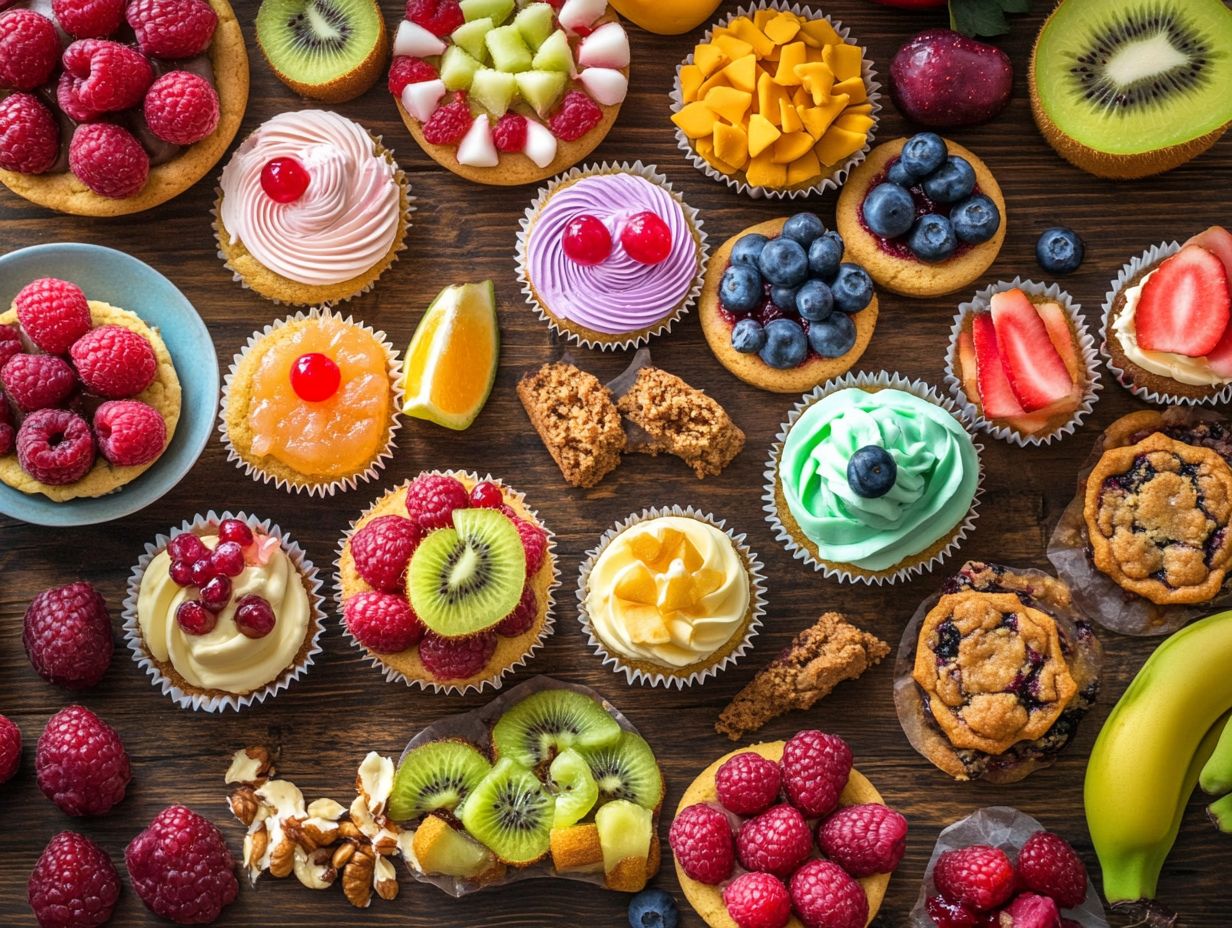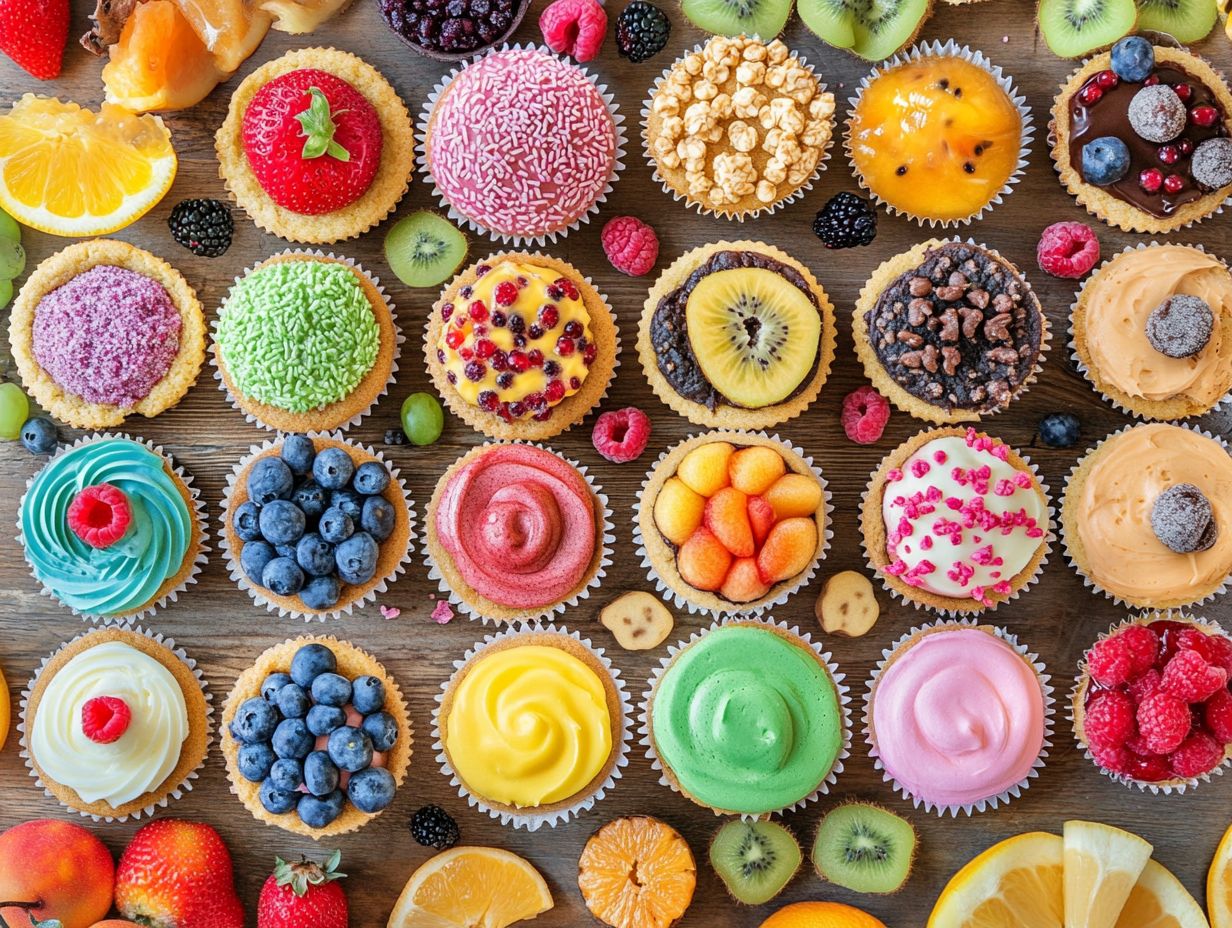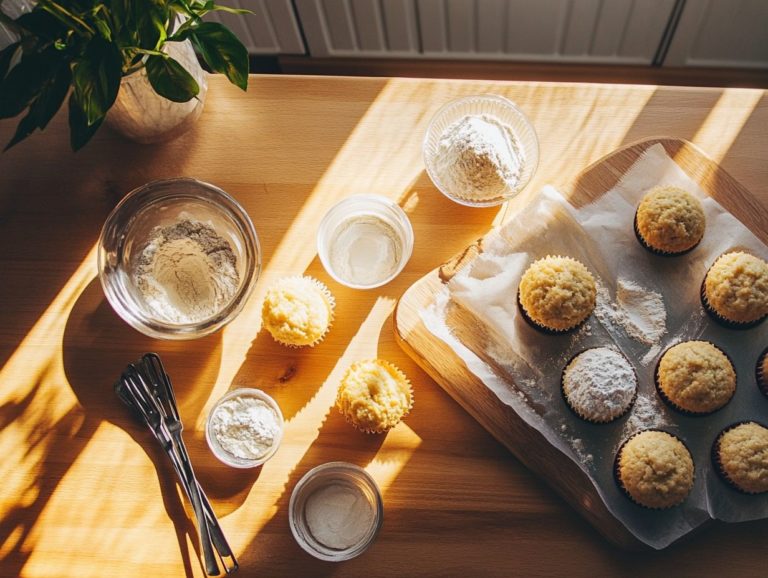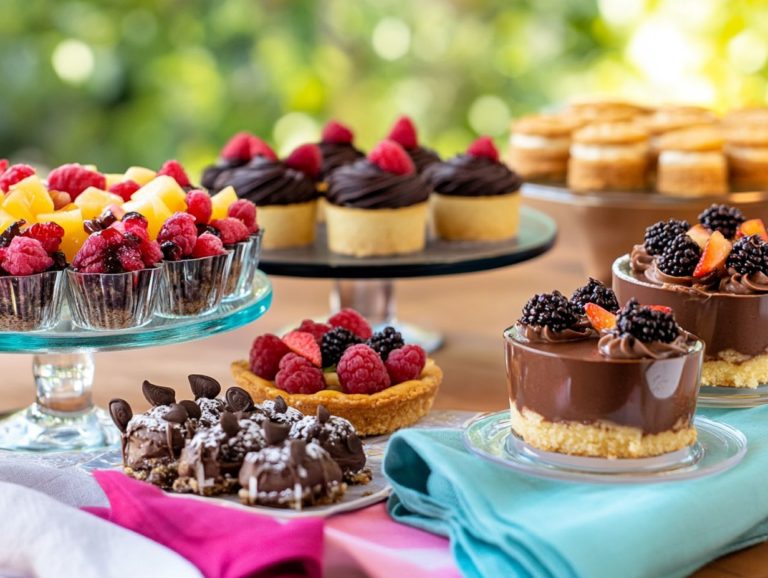The Health Benefits of Choosing Gluten-Free Sweets
Navigating the world of gluten can be quite the challenge, especially for individuals with gluten sensitivity, celiac disease, or a wheat allergy.
This article delves into the essentials of gluten, outlining what a gluten-free diet truly encompasses, including the health benefits and showcasing the delightful gluten-free food options available to you.
You ll uncover the benefits of indulging in gluten-free sweets, exploring their potential health advantages and how they stack up against traditional treats.
You ll also find valuable tips for incorporating these sweets into your diet, crafting your own creations, and staying alert to potential pitfalls.
Whether you re gluten-sensitive or simply curious, exciting flavors await you to explore!
Contents
- Key Takeaways:
- What is Gluten?
- What is a Gluten-Free Diet?
- What Foods Contain Gluten?
- Why Choose Gluten-Free Sweets?
- Incorporating Gluten-Free Sweets: Tips and Benefits
- How to Make Your Own Gluten-Free Sweets?
Key Takeaways:

- Gluten is a protein found in wheat, barley, and rye that some people have trouble digesting.
- A gluten-free diet eliminates these grains and can provide health benefits such as improved digestion, increased energy, and clearer skin.
- Gluten-free sweets are a great alternative for those with gluten sensitivities or celiac disease, allowing delicious treats without gluten’s negative effects.
What is Gluten?
Gluten is a collection of proteins predominantly found in grains such as wheat, barley, and rye. It can present considerable health challenges for those with celiac disease or non-celiac gluten sensitivity.
Understanding gluten s function within these grains is essential. It has the potential to provoke responses from the body s defense system in individuals with gluten-related disorders, resulting in a range of health complications, such as gluten ataxia and other autoimmune disorders.
For someone with celiac disease, gluten is far more than just a dietary consideration; it is a substance that can trigger severe autoimmune reactions. This underscores the critical importance of being vigilant about gluten intake.
What is a Gluten-Free Diet?
A gluten-free diet is a carefully curated nutritional approach that eliminates gluten, the protein present in wheat, barley, and rye. This dietary choice is not just a preference; it is vital for those diagnosed with celiac disease or gluten intolerance.
By adhering to a gluten-free diet, you are not only prioritizing your health but also actively preventing potential complications linked to gluten consumption. This regimen encourages you to embrace fresh, wholesome foods and whole grains like rice and quinoa.
However, it also requires you to be diligent about food labeling to steer clear of processed items that may have hidden gluten lurking within.
What Foods are Gluten-Free?
Gluten-free foods offer a diverse array of grains and products that leave gluten behind, allowing you to savor nutritious meals without the worry of adverse reactions. You ll find gluten-free grains like quinoa and rice, alongside seeds like flaxseed, all of which contribute to a well-rounded diet.
Understanding which foods are permissible is crucial for maintaining your health and energy, particularly if you need to manage your diet due to celiac disease or a gluten allergy.
To elevate your nutritional diversity, consider incorporating a wide range of gluten-free options such as buckwheat, millet, and corn. These ingredients can be transformed into various delightful dishes, from warm salads featuring quinoa to hearty rice bowls brimming with fresh vegetables and protein sources like grilled chicken or chickpeas.
When those sweet cravings strike, desserts crafted with almond flour or coconut flour are exquisite choices. Brands like Las Delicias Patisserie tempt you with scrumptious gluten-free pastries, while MyGFBakery presents a delightful selection of baked goods that cater to gluten-sensitive individuals, ensuring that your enjoyment of treats remains uncompromised by dietary restrictions.
In conclusion, exploring a gluten-free diet opens the door to numerous health benefits and delicious options. Embrace this journey towards better health and enjoy the wide range of gluten-free delights available to you!
What Foods Contain Gluten?
Foods containing gluten primarily come from grains such as wheat, barley, and rye, which are staples in numerous diets and often sneak their way into processed foods. If you have a gluten allergy or celiac disease, it’s crucial to understand which grains to avoid to steer clear of any adverse health effects.
These grains frequently make an appearance in bread, pasta, and baked goods, so being diligent about reading food labels is essential for your well-being. Gluten can also be found in many processed foods, including sauces, soups, and even certain salad dressings, making meal preparation a bit of a puzzle for those avoiding gluten.
Recognizing various names for gluten-containing ingredients, like malt and bulgur, can truly be a game-changer. The good news is that there s a wealth of gluten-free alternatives out there. Quinoa, rice, and gluten-free grains like sorghum and millet can be used to create delicious pasta and breads.
Embracing these substitutes not only protects your health but also opens up a world of cooking creativity, ensuring that your meals remain both enjoyable and nourishing.
Why Choose Gluten-Free Sweets?

Craving something sweet? Discover why gluten-free treats might be your new favorite indulgence! Opting for gluten-free sweets presents a delightful alternative for those who are sensitive to gluten, while also offering potential health benefits, particularly related to digestive health and weight management.
This dietary shift allows you to indulge in delicious treats without the unwanted effects of gluten, making it a wise choice for anyone committed to improving their health. Gluten-free sweets often use fresh ingredients, boosting their nutritional value and overall appeal.
What are the Health Benefits of Choosing Gluten-Free Sweets?
Choosing gluten-free sweets can bring a variety of health benefits your way, such as increased energy levels and a lower risk of nutritional deficiencies, especially if you have gluten-related conditions. By opting for gluten-free alternatives, you can savor desserts crafted from wholesome, full of essential nutrients ingredients that align with your dietary needs, all while satisfying your sweet tooth.
This thoughtful choice often leads to a more balanced diet, which can enhance your overall health. Research published in the Journal of Human Nutrition and Dietetics suggests that individuals adhering to a gluten-free diet may experience a noticeable boost in vitality, thanks to the inclusion of antioxidant-rich and high-fiber ingredients often found in gluten-free desserts.
Expert nutritionists point out that many gluten-free sweets utilize alternative flours like almond or coconut, which not only pack essential nutrients but also help maintain your energy levels throughout the day. By selecting gluten-free treats, you can combat the fatigue that frequently stems from nutritional deficiencies, paving the way for a vibrant and active lifestyle all while enjoying the delightful pleasures of sweet indulgence.
Are Gluten-Free Sweets Healthier than Regular Sweets?
When you compare gluten-free sweets to regular sweets, it s crucial to take a closer look at their nutritional value and overall health impact. Gluten-free sweets are specifically designed to avoid gluten, but their health benefits can differ significantly depending on the ingredients used.
This makes it essential for you to carefully assess their nutritional content, giving you the power to make informed choices that align with your health goals and dietary requirements. Many people mistakenly equate gluten-free with healthier, but that s not always the case.
For example, gluten-free sweets often replace wheat flour with alternative flours, sugars, and emulsifiers, which can actually lead to a higher calorie count or increased sugar content. By understanding the types of sweeteners, fats, and preservatives found in both gluten-free and regular sweets, you can gain valuable insights into their overall caloric load and potential health implications.
While gluten-free options are a must for those with celiac disease or gluten sensitivity, they can still contain ingredients that aren’t necessarily healthier. Therefore, it s wise to examine the labels closely before indulging in these treats.
Delicious Gluten-Free Sweet Options
You ll discover a wealth of delightful gluten-free sweets that cater to a variety of taste preferences and dietary needs. Bakeries like MyGFBakery and Chompie s provide an array of delectable treats that are satisfying and safe for those avoiding gluten. Keep an eye out for upcoming events, like the one on June 14, 2024, which may highlight innovative gluten-free creations!
For instance, you can indulge in MyGFBakery s rich and fudgy brownies made with almond flour and coconut sugar. They deliver an impeccable balance of sweetness and texture. Chompie s gluten-free blueberry muffins combine juicy berries with wholesome oats, making them a beloved choice for breakfast or a snack.
You don’t want to miss out on the delightful snickerdoodle cookies from The Happy Cookie! These are crafted with a special blend of gluten-free flours and spices for a warm, cinnamon-infused treat. Exploring these options satisfies your sweet cravings and opens a world of flavors that you might have thought were off-limits due to dietary restrictions.
Incorporating Gluten-Free Sweets: Tips and Benefits
Incorporating gluten-free sweets into your diet can transform how you satisfy your sweet tooth while adhering to dietary restrictions. This approach makes meal preparation enjoyable and health-conscious.
According to the Mayo Clinic, choosing allowed foods and avoiding grains not allowed can significantly improve health. By choosing gluten-free alternatives, you elevate your meals with delectable snacks that align perfectly with your healthy eating goals.
This integration fosters mindfulness in your eating habits and sparks creativity in the kitchen. It paves the way for a more varied and exciting diet! Utilizing fresh foods can enhance your meals and contribute to better health.
What are Some Tips for Finding Gluten-Free Sweets?

Finding gluten-free sweets can be a breeze when you follow a few essential tips. Start by always checking labels for gluten-free certifications, which are labels that indicate a product does not contain gluten. Familiarize yourself with reputable brands known for their gluten-free offerings. Brands like Las Delicias Patisserie and MyGFBakery are great options.
This proactive approach gives you the power to indulge in your favorite sweets without compromising your dietary needs. Using online resources can change the game by helping you identify certified gluten-free brands and locate specialty shops that cater specifically to gluten-free diets.
When navigating grocery store aisles, keep an eye out for designated gluten-free sections. Don t hesitate to ask store staff for assistance in finding suitable products. It s also worth exploring local bakeries that offer gluten-free options, as they often have unique treats that you won’t find in regular supermarkets. For instance, Las Delicias Patisserie has a wide range of gluten-free pastries.
Joining gluten-free communities online provides invaluable recommendations and tips. This makes your journey toward enjoying delicious gluten-free sweets not just easy, but truly enjoyable!
How to Make Your Own Gluten-Free Sweets?
Creating your own gluten-free sweets at home is not just rewarding; it s an opportunity to craft healthier, personalized treats while maintaining complete control over the ingredients you choose. By harnessing the potential of fresh produce and gluten-free flours, you can whip up a delightful array of desserts that cater to your unique tastes and dietary needs.
This journey allows for creative expression in the kitchen. It also deepens your understanding of gluten-free cooking.
Imagine the thrill of venturing beyond the usual sugar-laden options. Discover how the right ingredient combinations can yield enchanting flavors and textures. For example, using ripe bananas or avocados not only adds moisture but also provides a natural sweetness to your creations. Meanwhile, almond or coconut flour brings a distinct flavor that beautifully enhances your dishes.
Encouraging yourself to experiment with seasonal fruits or aromatic spices like cinnamon or nutmeg can transform even the most basic recipes into exquisite gluten-free confections. You ll take pride in sharing these delightful creations with friends and family while being mindful to avoid cross-contamination. Consider checking out health tips from the Journal of Human Nutrition and Dietetics for additional guidance on creating balanced meals.
Potential Risks of Gluten-Free Sweets
While gluten-free sweets can offer a delightful indulgence for those with gluten sensitivities, it s important to be aware of potential risks. Hidden allergens and excessive calorie content can lurk in these treats. According to the American College of Cardiology, careful planning and moderation are key to enjoying these treats safely.
Not all gluten-free options are created equal; some may be packed with unhealthy ingredients that undermine their perceived advantages. By understanding these risks, you empower yourself to make informed dietary choices that truly align with your health needs. Monitoring information from the Food and Drug Administration can help you stay updated on safe options.
Can Gluten-Free Sweets Contain Hidden Allergens?
Gluten-free sweets can sometimes hide allergens that may pose risks for individuals with food allergies, which makes careful reading of food labels absolutely essential. Even products proudly bearing the gluten-free label might sneak in other allergenic ingredients, so maintaining vigilance while indulging in these treats is a must. By staying informed about common allergens, you can enjoy gluten-free options without compromising your health.
Be aware that common allergens like:
- Nuts
- Dairy
- Soy
- Eggs
often find their way into gluten-free desserts, putting those with allergies at unintentional risk. This is particularly concerning because many people might mistakenly believe that gluten-free equates to being safe for them.
It s wise for you to familiarize yourself with ingredient lists and allergen statements on packaging, as regulations can differ from brand to brand. You can take a proactive approach by choosing certified gluten-free products that also emphasize allergen-free manufacturing processes. Engaging in discussions with local bakers or opting for made-from-scratch options can further assist you in identifying safer sweet treats.
Why not start your own sweet adventure today?
Can Gluten-Free Sweets be Higher in Calories?
Many gluten-free sweets can be surprisingly higher in calories than their gluten-containing counterparts. This raises valid concerns about their nutritional value and potential health implications. While these treats offer a delightful alternative for those with gluten sensitivities, don t overlook the importance of checking ingredients and portion sizes to avoid any unintended weight gain.
Understanding the caloric content of gluten-free sweets is crucial for maintaining a balanced diet. According to the Academy of Nutrition and Dietetics, balancing your diet with natural, whole ingredients can help you manage the calories you consume.
This discrepancy often stems from the use of alternative flours and sweeteners, which tend to be calorie-dense. For anyone adhering to a gluten-free lifestyle, it s vital to recognize that while these confections may be free of gluten, they can still significantly contribute to your overall caloric intake.
Incorporating gluten-free sweets into your diet should be done with a sense of caution; moderation is paramount. To help manage calorie consumption, consider opting for smaller portions or sourcing more natural ingredients. Pairing these indulgences with healthier options can also promote a balanced nutritional profile, allowing you to enjoy treats without the guilt.
Are There Any Side Effects of Consuming Gluten-Free Sweets?

While you may consider gluten-free sweets a safe haven in the dessert world, it’s essential to recognize that they can still come with their own set of side effects, particularly regarding your digestive health. The ingredients used in gluten-free baking might not always sit well with everyone, occasionally leading to discomfort or gastrointestinal issues. Being aware of these potential side effects is key to making informed choices. For the latest research on gluten-free diets, check out studies published in the Journal of Human Nutrition and Dietetics.
Sweeteners like sorbitol and xylitol, often found in gluten-free treats, can lead to bloating or gas for some individuals. The absence of gluten usually means that alternative flours such as almond or coconut flour are used. These can be high in fiber and may irritate a sensitive digestive system if consumed in excess.
To support better digestion, consider gluten-free sweets made from whole ingredients like fruit or oats, rather than heavily processed options. Taking a mindful approach when selecting gluten-free choices is vital for maintaining your digestive wellness.
Frequently Asked Questions
What are gluten-free sweets?
Gluten-free sweets are desserts or treats that do not contain gluten, a protein found in wheat, barley, and rye. They are suitable for individuals with gluten intolerance or celiac disease.
What are the health benefits of choosing gluten-free sweets?
Choosing gluten-free sweets can have various health benefits, including better digestion, improved energy levels, and reduced inflammation. It can also help individuals with gluten intolerance or celiac disease manage their condition better.
Are gluten-free sweets healthier than regular sweets?
Not necessarily. While gluten-free sweets may have some health benefits, they can also be high in sugar and calories, just like regular sweets. It is essential to read the nutrition labels and choose gluten-free sweets made with whole, natural ingredients.
Can gluten-free sweets help with weight loss?
Circle June 14, 2024, on your calendar for the latest updates on gluten-free weight loss trends!
Gluten-free sweets alone may not directly lead to weight loss. However, if you have a gluten intolerance and switch to gluten-free sweets, you may experience weight loss due to improved digestion and reduced inflammation in the body.
What are some examples of gluten-free sweets?
- Flourless chocolate cake
- Rice crispy treats made with gluten-free cereal
- Gluten-free brownies
- Fruit sorbet
There are also many gluten-free baking mixes and recipes available for cookies, cakes, and other traditional desserts.
Are There Any Potential Downsides to Choosing Gluten-Free Sweets?
One potential downside is that gluten-free sweets can be more expensive than regular sweets. They may also be harder to find, especially in smaller towns or rural areas. Additionally, some gluten-free sweets may not taste as good as their gluten-containing counterparts. Therefore, it is essential to read reviews or sample products before buying in bulk.






